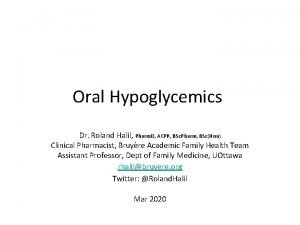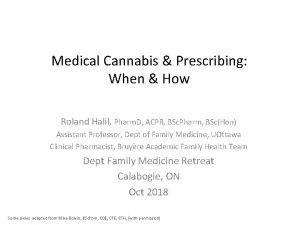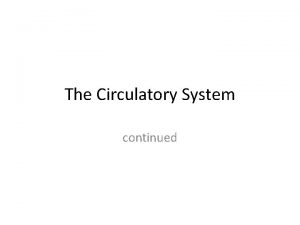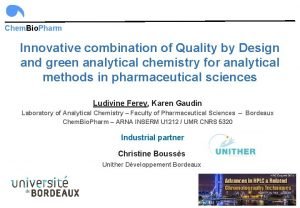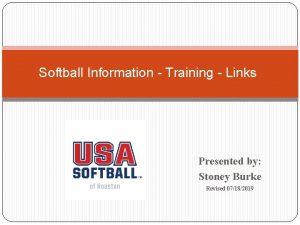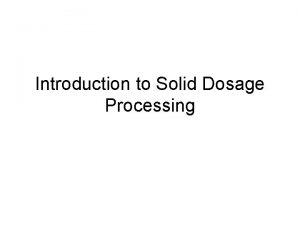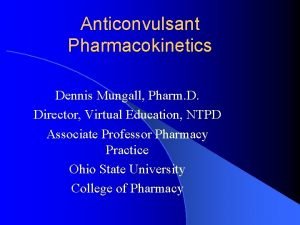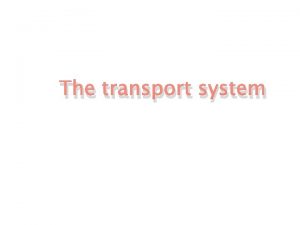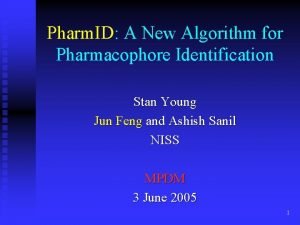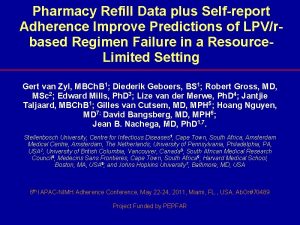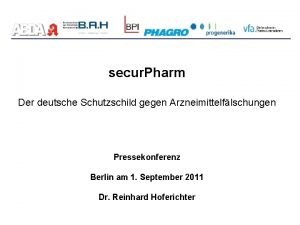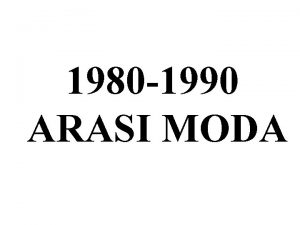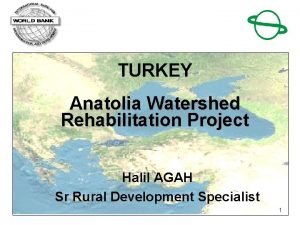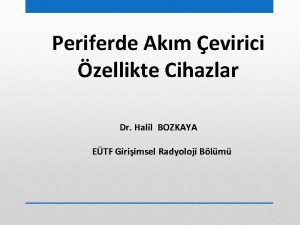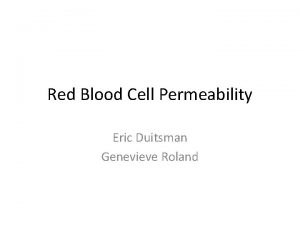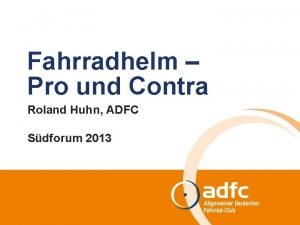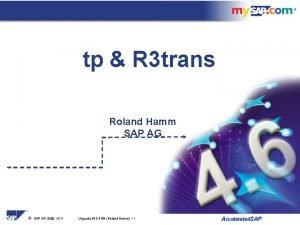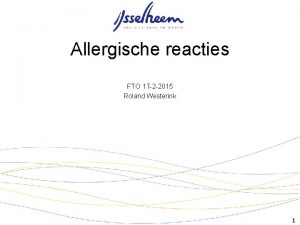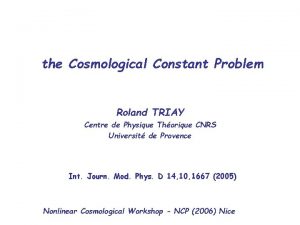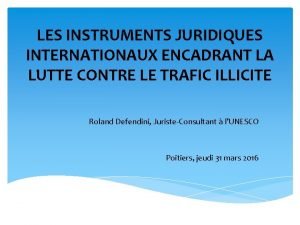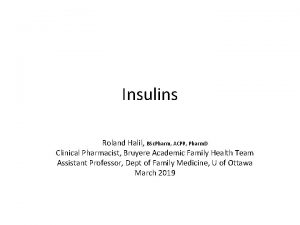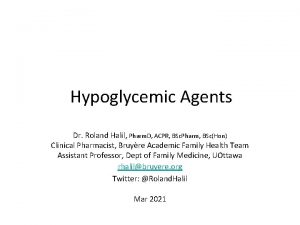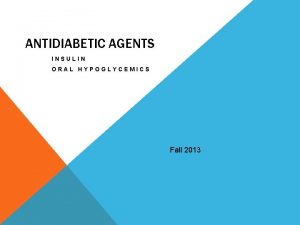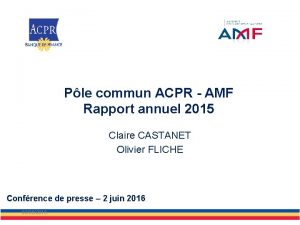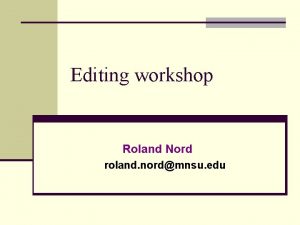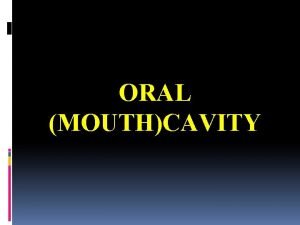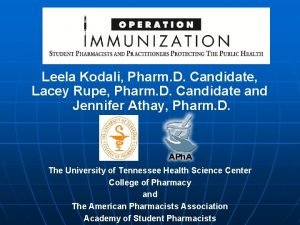Oral Hypoglycemics Dr Roland Halil Pharm D ACPR















































- Slides: 47

Oral Hypoglycemics Dr. Roland Halil, Pharm. D, ACPR, BSc. Pharm, BSc(Hon) Clinical Pharmacist, Bruyère Academic Family Health Team Assistant Professor, Dept of Family Medicine, UOttawa rhalil@bruyere. org Twitter: @Roland. Halil Mar 2020

Disclosures Relationships with Commercial Interests: – Consultant with the Foundation for Medical Education at Mc. Master University (non-profit org) • (PBSG module consultant & reviewer) – Occasional consultant with Rxfiles (non-profit org) Disclosure of Commercial Support : None Potential for Conflict(s) of Interest: None

Objectives • List the classes of oral antihyperglycemic agents and understand their place in therapy. – Determine the relative efficacy, toxicity, cost and convenience of these agents before choosing therapy – Rationalize prescribing of oral hypoglycemics • Describe the current approach to pharmacologic management of type 2 diabetes.

Targets A 1 C Target for most people with diabetes < 7. 0% Fasting blood Post-prandial glucose 2 h (sugar) after eating (mmol/L) 4. 0 - 7. 0 4. 0 - 10. 0 Diabetes Canada. MANAGING YOUR BLOOD SUGAR https: //www. diabetes. ca/diabetes-and-you/healthy-living-resources/blood-glucose-insulin/managing-your-blood-sugar Accessed July 23/18

Diabetes: complications MACROvascular Stroke Heart disease & hypertension MICROvascular Diabetic eye disease (retinopathy & cataracts) Nephropathy Peripheral vascular disease Neuropathy Foot problems

Priorities / Goals of Care Lifestyle Modification / Weight Loss Quality of evidence: • All RCT / cohort data Time to benefit: • All in months Quantity of benefit? 1 ↓ Mortality via: Glycemic Control Vascular Protection

Lifestyle Modification & Weight Loss Finnish Diabetes Trial • Pre-diabetics (n = 522) • Moderate wt loss (5%) (esp. abd fat) • Physical activity – > 150 min/week • 12% ARR / 58% RRR for DM 2 at 4 years – 11% (95% CI 6 -15%) vs. – 23% (95% CI 17 -29%) N. B. Drugs ~ 30% RRR Di. RECT trial • Diabetics (n = 306) – Specially-formulated 800 calorie liquid diet – Consisted of 4 shakes that replaced all meals x 3 -5 months • 15 kg wt loss at 1 yr – 24% vs. 0% control (p<0. 0001) NNT=5 • DM 2 remission at 1 yr – 46% vs. 4% control (p<0. 0001, O. R. 19. 7, 95% Cl 7. 8 -49. 8) NNT=3 – 36% remission at 3 yrs Bariatric surgery (all types) ROUX-EN-Y GASTRIC BYPASS SLEEVE GASTRECTOMY ADJUSTABLE GASTRIC BAND DUODENAL SWITCH • Bariatric surgeries in >135, 000 pts found: • Improves DM 2 in 90% • DM 2 remission in 78% – American Society for Metabolic and Bariatric Surgery (ASMBS)

Diabetes Previously, DM 2 = MI equivalent – Automatic Rx for: • ASA, statin, ACEinh • Currently…

Vascular Protection & Glycemic Control • Any ACEinh or ARB – Unclear benefit at lower risk – Clear benefit at higher risk • Any Statin – Unclear benefit at lower risk – Clear benefit at higher risk • Metformin – UKPDS-34 trial – Diabetes-specific mortality • (= Death from MI, stroke, PVD, kidney disease, hypo- or hyperglycemia, or sudden death). • Metformin vs. intensive: – 7. 5 vs. 10. 3 (P=0. 11) • Metformin vs. diet: – 7. 5 vs. 12. 7 (P=0. 017) • 2. 8% - 5. 2% ARR • ASA – NNT ~ NNH (1’ prevention) – All-cause mortality • Metformin vs. intensive: – 13. 5 vs. 18. 9 (P=0. 021) • Metformin vs. diet: – 13. 5 vs. 20. 6 (P=0. 011) • 5. 4% - 7% ARR

2 ↓ Morbidity via: Prevention of Microvascular Complications & Hgb-A 1 C Targets Retinopathy 16 14 12 Rate per patient-years • Intensive vs Conventional insulin therapy (n=110) • Median A 1 c: 7. 1% vs 9. 4% 10 8 6 4 2 0 7% 5 6 7 8 9 Hb. A 1 c (%) 10 11 Nephropathy 16 14 12 10 8 6 7% 4 2 0 5 6 7 8 9 10 11 Hb. A 1 c (%) Shichiri M et al. Long-term results of the Kumamoto Study on optimal diabetes control in type 2 diabetic patients. Diabetes Care. 2000 Apr; 23 Suppl 2: B 21 -9.

Prevention of Diabetes in IGT • Lifestyle modification – (see Finnish Diabetes Trial) – Moderate weight loss (5%) (esp. abd fat) – Regular physical activity • > 150 minutes per week – 58% RRR for type 2 Diabetes at four years • Pharmacotherapy – Multiple effective trials • Eg. LIFE trial - Losartan onset of new DM 2 Can J Diabetes 2003; 27(2); S 12 Based on the Finnish Diabetes Prevention Study and the Diabetes Prevention Program

Pharmacological Prevention Studies Study Drug Duration (years) RRR (%) DPP Metformin 850 mg BID 2. 8 31 STOPNIDDM Acarbose 100 mg TID 3. 3 30 DREAM Rosiglitazone 8 mg daily 3. 0 55 XENDOS Orlistat 120 mg TID 4. 0 37

Non-Pharmacologic Tx Mainstay of therapy! • Nutrition therapy – ↓ A 1 c 1 -2% – CDA recommends counseling by a dietician for all type 2 diabetics – www. cvtoolbox. com diet for Type 2 diabetes Can J Diabetes 2003; 27(2); S 27

Pharmacotherapy Comparison of antihyperglycemics

Pharmacotherapy Drug Classes Sensitizers Secretagogues Other

Drug Classes Sensitizers Secretagogues • Metformin • Glitazones (TZD) • Sulfonylureas – Eg. Glyburide, Gliclazide • Meglitinides – Rosiglitazone (Avandia®) – Pioglitazone (Actos®) – Eg Repaglinide (Gluconorm®) Other • Alpha glucosidase inhibitors (Acarbose) SGLT 2 inhibitors (Cana- Dapa- Empagliflozin) • DPP 4 inhibitors (Gliptins) Incretin (GLP 1) Analogues • Sitagliptin, Linagliptin * Liraglutide , Dulaglutide, Lixisenatide, • Saxagliptin, Alogliptin * Exenatide, Semaglutide (all sc inj)

Pharmacology Sensitizers • Metformin • Glitazones (TZD) – Rosiglitazone (Avandia®) – Pioglitazone (Actos®) Lexicomp® 2018 • Reduce insulin resistance • Increase glucose uptake & utilization in muscle and adipose tissue • Reduce hepatic glucose output

Drug Classes Sensitizers Secretagogues • Metformin • Glitazones (TZD) • Sulfonylureas – Eg. Glyburide, Gliclazide • Meglitinides – Rosiglitazone (Avandia®) – Pioglitazone (Actos®) – Eg Repaglinide (GLUCONORM) Other • Alpha glucosidase inhibitors (Acarbose) gliflozin) SGLT 2 inhibitors (Cana-, Dapa, Empa- • DPP 4 inhibitors (Gliptins) Incretin (GLP 1)Analogues • Sitagliptin, Linagliptin * Liraglutide , Dulaglutide, Lixisenatide, • Saxagliptin, Alogliptin * Exenatide, Semaglutide (all sc inj)

Pharmacology • ↑Basal and prandial insulin secretion Secretagogues – ↓hepatic gluconeogenesis Secretagogues • Sulfonylureas • Doesn’t correct impaired – Eg. Glyburide, Gliclazide 1 st phase insulin secretion; primarily affects 2 nd phase • Meglitinides • Beta-cell sensitizer – – Eg Repaglinide (Gluconorm®) primes glucose mediated insulin secretion (1 st phase) Lexicomp® 2018

Drug Classes Sensitizers Secretagogues • Metformin • Glitazones (TZD) • Sulfonylureas – Eg. Glyburide, Gliclazide • Meglitinides – Rosiglitazone (Avandia®) – Pioglitazone (Actos®) – Eg Repaglinide (GLUCONORM) Other • Alpha glucosidase inhibitors (Acarbose) gliflozin) SGLT 2 inhibitors (Cana-, Dapa, Empa- • DPP 4 inhibitors (Gliptins) Incretin (GLP 1)Analogues • Sitagliptin, Linagliptin * Liraglutide , Dulaglutide, Lixisenatide, • Saxagliptin, Alogliptin * Exenatide, Semaglutide (all sc inj)

Pharmacology: Other • Alpha glucosidase inhibitors (Acarbose) • Competitive inhibitor of pancreatic α-amylase and intestinal brush border α-glucosidases, resulting in delayed hydrolysis of ingested complex carbohydrates and disaccharides and absorption of glucose; Dose-dependent reduction in postprandial serum insulin and glucose peaks; inhibits the metabolism of sucrose to glucose and fructose • SGLT 2 inhibitors (Canagliflozin, Dapagliflozin, Empagliflozin) – Inhibits sodium-glucose cotransporter 2 (SGLT 2) in the proximal renal tubules, reducing reabsorption of filtered glucose from the tubular lumen and lowering the renal threshold for glucose (RTG). SGLT 2 is the main site of filtered glucose reabsorption; reduction of filtered glucose reabsorption and lowering of RTG result in increased urinary excretion of glucose, thereby reducing plasma glucose concentrations. • DPP 4 inhibitors (Gliptins) – (Sitagliptin, Lingliptin, Saxagliptin, Alogliptin) • Prolongs the action of endogenous incretin hormones by blocking their breakdown by the enzyme, dipeptidyl peptidase-4 (DPP-4). This leads to more insulin release after eating. • Incretin (GLP 1) Analogues – (Liraglutide, Exenatide, Semaglutide, Dulaglutide) – sc injection – mimic endogenous incretin hormones Lexicomp® 2018

So Many Options! How to Choose? • FOUR steps to Rational Prescribing: 1. Benefit 2. Harm 3. Cost 4. Convenience

Rational Prescribing Prioritize: a) Type of harm b) Quantity of harm c) Quality of evidence d) Time to harm Prioritize: a) Type of benefit b) Quantity of benefit c) Quality of evidence d) Time to benefit 1 Benefit 3, 4 Harm Cost & Convenience Roland Halil, Pharm. D, ACPR, BSc. Pharm, BSc(Hon) © 2

Benefit: 1 st: Hard Outcomes a) Mortality benefit – Metformin – UKPDS-34 trial • GLP 1 analogs: – Liraglutide – LEADER trial – Semaglutide – SUSTAIN-6 trial – Dulaglutide – REWIND trial – – • (Only in fatal stroke)(not MI) None with Exenatide - EXSCEL trial None with Lixisenatide ELIXA trial • SGLT 2 -inh: – Empagliflozin – EMPA-REG trial • (2 o prevention trial) – Dapagliflozin – DAPA-HF trial – Canagliflozin – CREDENCE trial • ? Insulin – “legacy effect” – 1 yr tight control = reduced M&M 10 yrs later! (UKPDS) b) Morbidity benefit (Reduction in microvascular outcomes) • Older meds have shown a morbidity benefit • Newer meds show a reduction in Hb. A 1 c • Metformin • Acarbose – MERIA meta-analysis – (Driven by non-fatal MI) • All GLP 1 analogs: – Albiglutide – HARMONY trial • (USA only) • All SGLT 2 -inh: – Canagliflozin – CANVAS & CREEDENCE trials – Dapagliflozin – DECLARE trial

Cardiovascular outcome trials Home P. Cardiovascular outcome trials of glucose-lowering medications: an update. Diabetologia. 2019 Mar; 62(3): 357 -369. doi: 10. 1007/s 00125 -018 -4801 -1. https: //link. springer. com/content/pdf/10. 1007%2 Fs 00125 -018 -4801 -1. pdf

Benefit 1 st: HARD Outcomes 2 nd: SURROGATE Outcomes Recently reported in 2019: (with top level announcements already made): – PIONEER 6 (oral semaglutide) • As safe as placebo (non-inferior) • No better for MACE / CV outcomes Coming soon 2020: – VERTIS CV Study (Ertugliflozin) • Pending – results soon c) Hb. A 1 c reduction • • • Any drug that reduces Hgba 1 c < 7% Blood glucose level reduction Fasting or Prandial d) Insulin Sparing Effects – Avoidance of hyperinsulinemia and associated risk factors (metabolic syndrome, atherosclerosis, elevated TGs/UA/weight/BP, etc. )

Benefit 2 c) Hb-A 1 c reduction – – ~ 1% to 2% • • • Metformin Sulfonylureas Repaglinide Glitazones (TZDs) Canagliflozin (1% - 2%) • Liraglutide (GLP 1 analogs) (1% - 2%) (1% - 1. 5%) (0. 4% - 1. 5%) (0. 8 – 1%) ~ 0. 5% to 1% • • Acarbose DPP 4 inhibitors (‘Gliptins) Dapagliflozin, Empagliflozin Nateglinide Nathan DM, et al. Diabetes Care 2008 (Dec); 31: 1 -11 Diabetes Canada 2018 Clinical Practice Guidelines for the Prevention and Management of Diabetes in Canada. Can J Diabetes. 2018; 42(Suppl 1): S 1 -S 325

Benefit 2 d) Insulin Sparing Effect = Weight neutral or weight negative = Reduction of hyperinsulinemia – METFORMIN – ACARBOSE – TZD’s (GLITAZONE’s) – DPP 4 inh (‘gliptins) – Incretin (GLP 1) Analogues (Liraglutide, Semaglutide etc. ) – SGLT 2 inh (Empagliflozin etc. )

Consider Harm Ask yourself… Bothersome Common Rare Severe Not legal Who cares • Age? • • Newer agents Older agents = = Less Safety Data More Safety Data

Harm Serious / Rare • Glitazones – – • Secretatgogues CHF Fractures M. I. (Sulfonylureas & Meglitinides) • – Severe Hypoglycemia (rosiglitazone) Bladder Cancer • (pioglitazone)

Harm Serious / Rare • SGLT 2 inhibitors (FDA OK 2013; H. Can. OK 2015) – Euglycemic DKA • 73 cases (March 2013 to May 2015 in FDA Adverse Event Reporting System (FAERS) database https: //www. fda. gov/Drugs/Drug. Safety/ucm 475463. htm – Fournier gangrene • – 55 cases in six years of / necrotising fasciitis in the perineum (FDA warning) • Incretin (GLP 1) Analogues (H. Can. approved in 2010) • DPP 4 inhibitors (‘gliptins) • ? Heart failure – Sitagliptin (Approved in 2008) • No, per 2015 TECOS trial (n = 14, 671) • Initially, Yes, per lower quality data [2014 post hoc pooled analysis of 25 RCTs (n = 1261)] Urosepsis • – 19 cases (2013 -2014)(FAERS) database ? Bone fracture & Amputation (Canagliflozin) • • CANVAS trial (Y) CREDENCE trial & OBSERVE-D meta-analysis (No) = Unknown – a bit too new – Linagliptin – No (per CARMELINA tial) – Saxoglitpin – Yes? (SAVOR-TIMI 53 trial) – Alogliptin - Yes? (EXAMINE trial) • ? Pancreatitis – maybe – – Yes per Faillie 2014 (PMID: 2435244) & Lee 2019 (PMID: 31431452) No per Chou 2014 (PMID: 24859164) & Thomsen 2015 (PMID: 25633664) = New; ? Reasonable safety data

Harm Serious / Rare • Metformin • ? Risk of Lactic Acidosis – 0. 03 to 0. 06 cases / 1000 pt-yrs – ~ 50% fatal – When implicated: • Based on case reports – Primarily diabetics w/ significant renal insufficiency, both intrinsic renal disease and renal hypoperfusion, w/ multiple medical/surgical problems and multiple medications. – Phenformin pulled from market due to L. A. in 1977 • Cohort studies and retrospective reviews: – Zero risk of lactic acidosis with metformin

Metformin Dosing • Dosing recommendations with renal insufficiency: • Cr. Cl > 30 m. L/min→ full dose – 2. 5 g/day • Cr. Cl = 20 – 30 m. L/min→ reduced dose – 1 g/day (If NO other risk factors, else D/C) – Take home: Assess OTHER RISK FACTORS for lactic acidosis 1) Salpeter SR, et al. Risk of fatal and nonfatal lactic acidosis with metformin use in type 2 diabetes mellitus. Cochrane Database of Systematic Reviews 2010, Issue 4. Art. No. : CD 002967. http: //www. cochrane. org/CD 002967/ENDOC_risk-of-fatal-and-nonfatal-lactic-acidosis-with-metformin-use-in-type-2 diabetes-mellitus Accessed Sept 24, 2015 2) Nasri, H. et al. Metformin: Current knowledge. J Res Med Sci. 2014 Jul; 19(7): 658– 664. PMCID: PMC 4214027 http: //www. ncbi. nlm. nih. gov/pmc/articles/PMC 4214027/ Accessed Sept 24, 2015 3) A A Tahrani, et al. Metformin, heart failure, and lactic acidosis: is metformin absolutely contraindicated? BMJ. 2007 Sep 8; 335(7618): 508– 512. PMCID: PMC 1971167. http: //www. ncbi. nlm. nih. gov/pmc/articles/PMC 1971167/ Accessed Sept 24, 2015 4) Lalau JD. Lactic acidosis induced by metformin: incidence, management and prevention. Drug Saf. 2010 Sep 1; 33(9): 727 -40. PMID: 20701406 5) Lazarus B, Wu A, Shin J, et al. Association of Metformin Use With Risk of Lactic Acidosis Across the Range of Kidney Function. A Community-Based Cohort Study. JAMA Intern Med. Published online June 04, 2018. doi: 10. 1001/jamainternmed. 2018. 0292 https: //jamanetwork. com/journals/jamainternalmedicine/article-abstract/2682516 Accessed June 7, 2018

Risk Factors - Lactic Acidosis • Severe renal impairment – (caution if Cr. Cl < 30 ml/min) and • • Hepatic disease alcoholism CHF COPD CRF Pneumonia Ongoing acidosis – Lactic, keto etc.

Harm Common / Bothersome 1) METFORMIN – GI upset / diarrhea – Start low, go slow! • Initial dose 250 mg QDaily to BID – B 12 / folate deficiency / anemia (6 - 8/100) • Reduced absorption – so, supplement – Anorexia – usually transient

Harm Common / Bothersome 2) Sulfonylureas: – Sulfa skin reactions • Rash / photosensitivity ~1% – Weight gain (2 -3 kg) – Mild Hypoglycemia: • Most with glyburide. Least w/ glimepiride & gliclazide • Requires consistent food intake • Major episodes 1 -2% (esp. in elderly)

Harm Common / Bothersome 3) Glitazones: – Edema 4) Meglitinides: – Hypoglycemia 5) Acarbose: – GI upset / diarrhea / bloating 7) Incretin (GLP 1) analogues – 8) SGLT 2 inhibitors – – – 6) Gliptins: – GI upset, edema, ? infection N/V/D, ? infection Hyper. K+, ARF (AKI) UTI (includes bacteriuria [asymptomatic], cystitis: 9%; females: 4%-18%; males: 4%), Genitourinary fungal infection (4%; females: 5% to 11% [includes bacterial vaginosis, cervicitis, vulvovaginal candidiasis, vulvovaginal infection, vulvovaginitis]; – males: 2% to 3% [includes balanitis, balanoposthitis, genitourinary fungal infection, penile infection, scrotal abscess])

Cost • Patient cost vs Societal cost • Rx cost? • ODB coverage? • Covered under other plans?

Cost • From Rxfiles Nov 2019 • = Cost($)/100 days (in Sask. ) • Alternatively, check ODB e-formulary here: – N. B. Not true pt costs – Only comparative costs http: //www. rxfiles. ca/rxfiles/uploads/d ocuments/members/cht-diabetes. pdf

Cost ODB e-formulary comparative costs To estimate pt costs: (add ~10% x No. days) + ~$10 dispensing fee ODB e-formulary https: //www. formulary. health. gov. on. ca/formulary/ Accessed Aug 9, 2018

Convenience • PO vs IV? • QD vs QID? • Lab monitoring?

Convenience • • • Gliptin’s Glitazones SGLT 2 inh DPP-4 inhibitors GLP-1 analogs Sulfonylureas Metformin Meglitinides Acarbose - QD - QD sc inj – QD to BID - QD to TID – QD to TID with meals


Summary • 1 st line – Metformin – CV benefit, renal benefit, very safe, cheap, simple • 2 nd line – Semaglutide (Ozempic®) – CV benefit, renal benefit, wt loss, ODB covered, weekly sc injection • 3 rd line: – If no previous MI/CHF: Anything else (except TZDs) – If previous MI/CVA or CHF: Dapagliflozin (Forxiga®) • CV benefit, renal benefit, CHF specific benefit, ODB covered, combo pill with Metformin (Xigduo®) • But, closely monitor SCr, K+, UTI sxs etc

Review of Basic Concepts 1. Reduce mortality – BP control w/ ACEi/ARB – Plaque stabilization with statin – ? ASA – Glycemic control with Metformin • ? GLP 1 analogs (Liraglutide) • ? SGLT 2 inh (Empagliflozin) • ? Acarbose 2. Reduce morbidity – Glycemic control to prevent microvascular complications • Glycemic Control Priorities 1. Hypoglycemia is Acute 1. Correct any 2. Hyperglycemia is hypoglycemia Chronic ASAP st So, target Hypo 1 then, 1. Fasting sugars: 18 h/24 h 2. AM FBS = 75% 3. Noon FBS 2. Fed sugars: 6 h/24 h = 4. PM FBS 25% 5. HS FBS So, target Fasting 1 st then, 6. AM 2 h PPG • AM affects PM So, target AM 1 st 7. Noon 2 h PPG 8. PM 2 h PPG

Summary • Pathophysiology of disease underscores the key targets for modification – Insulin resistance / hyperinsulinemia • Pharmacology of agents underscores ideal vs. suboptimal combinations of agents • Rational Prescribing principles underscore priorities for investment in benefit/risk ratios

Questions? Dr. Roland Halil, Pharm. D, ACPR, BSc. Pharm, BSc(Hon) Clinical Pharmacist, Bruyere Academic Family Health Team Assistant Professor, Dept of Family Medicine, UOttawa Mar 2020 rhalil@bruyere. org Twitter: @Roland. Halil
 Roland halil
Roland halil Roland halil
Roland halil Roland halil
Roland halil Library.med.utah.edu/kw/pharm/hyper heart.html
Library.med.utah.edu/kw/pharm/hyper heart.html Peptide api manufacturers
Peptide api manufacturers Bc bio-pharm
Bc bio-pharm Klucel exf pharm
Klucel exf pharm Nicole noel purdue
Nicole noel purdue Outfield pharm
Outfield pharm Pharmlinks
Pharmlinks Pharm
Pharm Forensic pharmacist
Forensic pharmacist Letazol
Letazol Pharm gkb
Pharm gkb What is the transport system of the body
What is the transport system of the body Pharm id
Pharm id Pharm
Pharm Pharm406
Pharm406 Secur pharm
Secur pharm Doç dr halil özdemir
Doç dr halil özdemir Moda 1980
Moda 1980 Halil agah
Halil agah Epinoryum
Epinoryum Halil bozkaya
Halil bozkaya Halil bekmezci anadolu lisesi üniversite başarısı
Halil bekmezci anadolu lisesi üniversite başarısı Karacer
Karacer Progesyon
Progesyon Ibrahim per
Ibrahim per Genevieve roland
Genevieve roland Roland hoheisel-gruler
Roland hoheisel-gruler Roland zu bremen oberschule
Roland zu bremen oberschule Publicidad con simil
Publicidad con simil Ellen roland
Ellen roland Fahrrad helmpflicht pro und contra tabelle
Fahrrad helmpflicht pro und contra tabelle Rddmasgl
Rddmasgl Roland barthes death of the author
Roland barthes death of the author Roland sundström
Roland sundström Ellen roland
Ellen roland Roland westerink
Roland westerink Roland triay
Roland triay Five codes of roland barthes
Five codes of roland barthes Roland flury
Roland flury Roland robertson globalization
Roland robertson globalization Roland purcell a technical writer
Roland purcell a technical writer Roland defendini
Roland defendini Roland guijt
Roland guijt Roland michel tremblay
Roland michel tremblay Roland ess
Roland ess
